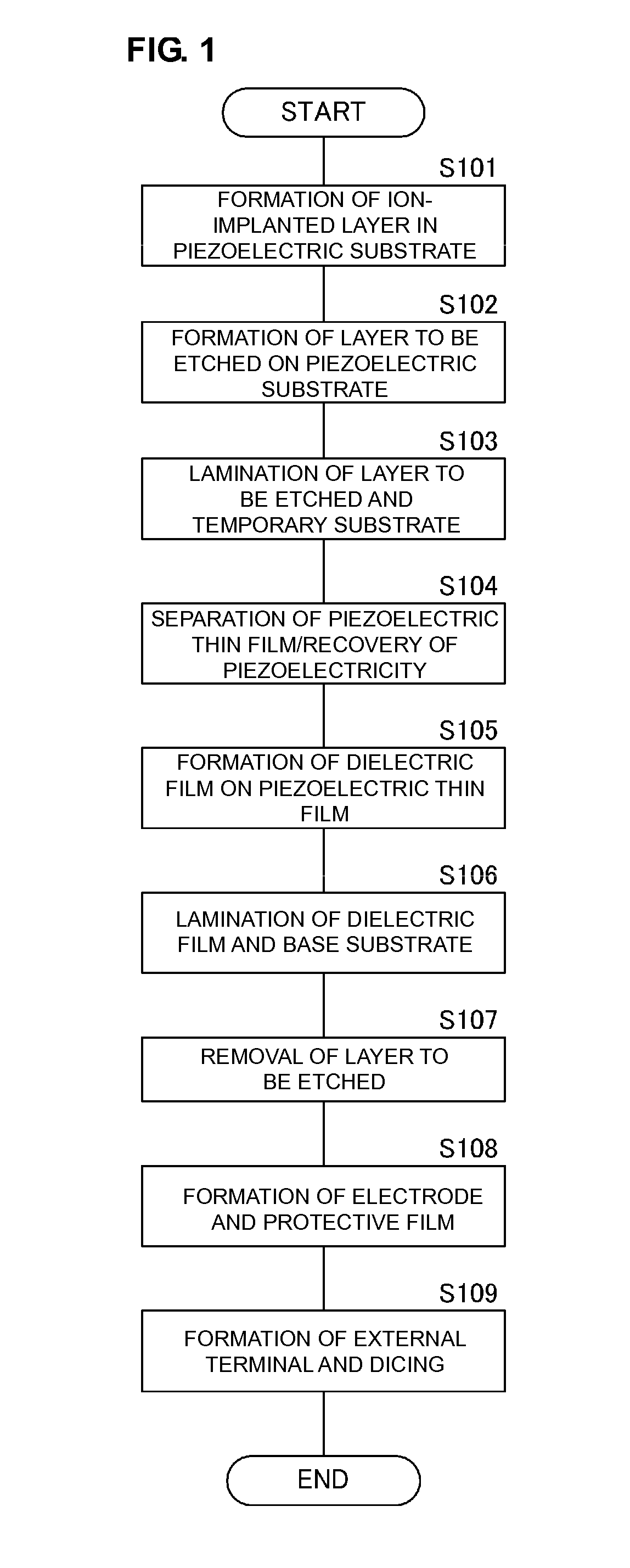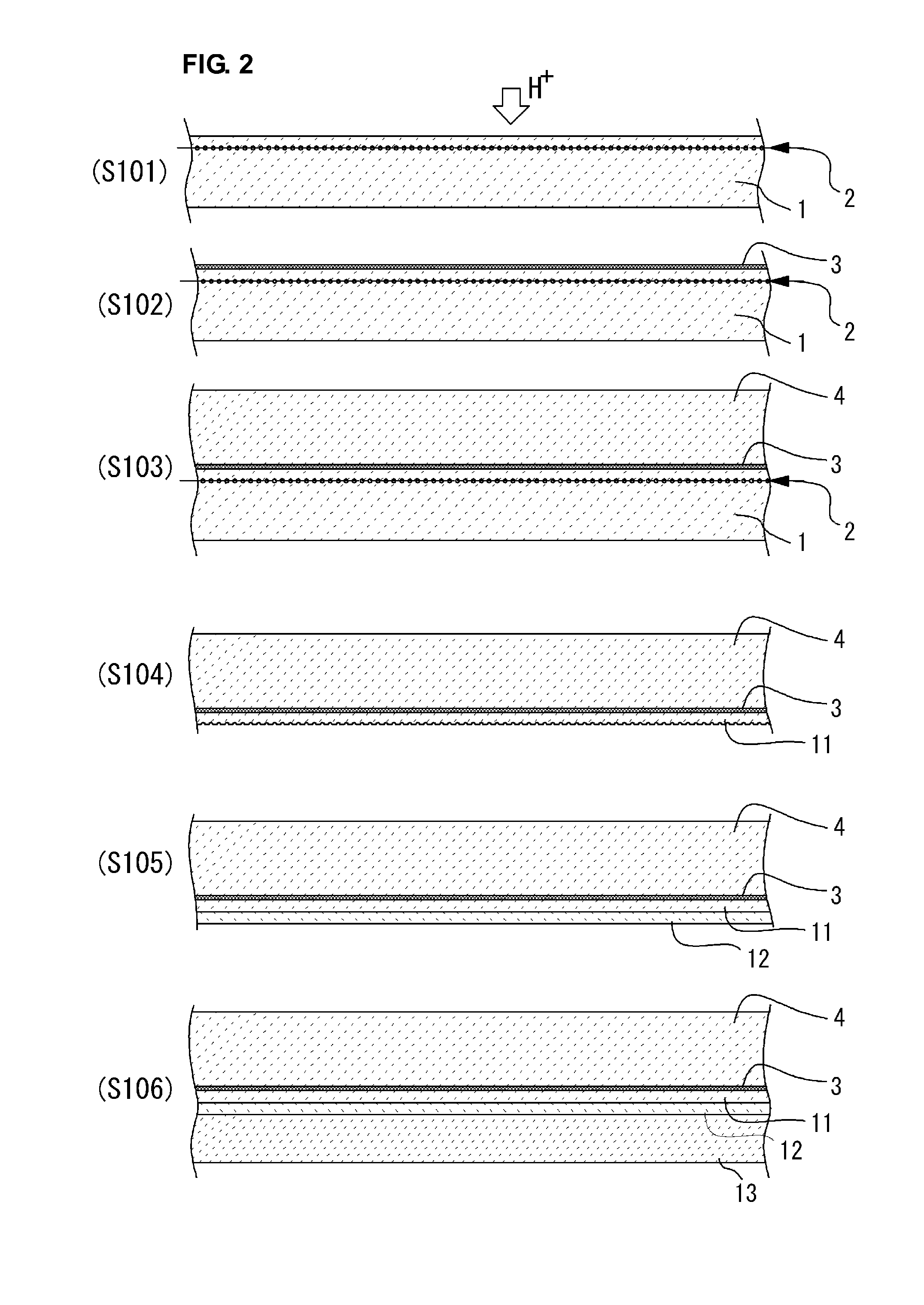Method for manufacturing composite piezoelectric substrate and piezoelectric device
a piezoelectric substrate and composite piezoelectric technology, applied in the direction of piezoelectric/electrostrictive device details, device details, generators/motors, etc., can solve the problem of difficult commercial manufacture of large composite piezoelectric substrates, adversely affecting the piezoelectricity of composite piezoelectric substrates, and the material of a supporting substrate cannot have much less linear expansion coefficients
- Summary
- Abstract
- Description
- Claims
- Application Information
AI Technical Summary
Benefits of technology
Problems solved by technology
Method used
Image
Examples
first preferred embodiment
A method for manufacturing a surface acoustic wave device including a composite piezoelectric substrate according to a first preferred embodiment of the present invention will be described below with reference to FIGS. 1 to 4B. FIG. 1 is a flow chart of a method for manufacturing a surface acoustic wave device according to the first preferred embodiment. FIGS. 2 and 3 are schematic cross-sectional views of manufacturing steps described in the flow chart in FIG. 1.
First, an ion implantation step is performed on a piezoelectric substrate 1 (FIGS. 1 and 2: S101). The piezoelectric substrate 1 is preferably a single-crystal substrate made of a piezoelectric substance, for example. In the ion implantation step, ions are implanted into a flat main surface of the piezoelectric substrate 1 to form an ion-implanted portion 2 in the main surface.
The piezoelectric substrate 1 is preferably a LiTaO3 (LT) single-crystal substrate, for example. The piezoelectric substrate 1 can be divided by the ...
second preferred embodiment
A method for manufacturing a bulk wave device including a composite piezoelectric substrate according to a second preferred embodiment of the present invention will be described below with reference to FIGS. 5 to 8B. FIG. 5 is a flow chart of a method for manufacturing a bulk wave device according to the second preferred embodiment. FIGS. 6 and 7 are schematic cross-sectional views of manufacturing steps described in the flow chart in FIG. 5.
In the same or substantially the same manner as in the first preferred embodiment, an ion implantation step is performed first (FIG. 5: S201). An etching layer forming step is then performed (FIG. 5: S202). A temporary supporting step is then performed (FIG. 5: S203). A heating step is then performed (FIGS. 5 and 6: S204). A temporary supporting substrate including a layer to be etched 23 and a temporary substrate 24 is formed on the ion-implanted surface of a piezoelectric thin film 31 preferably having a thickness of approximately 1 μm, for ex...
third preferred embodiment
A method for manufacturing a gyro device including a composite piezoelectric substrate according to a third preferred embodiment of the present invention will be described below with reference to FIGS. 9 to 11. A gyro device vibrates a silicon diaphragm with a piezoelectric vibrator, and detects the Coriolis force acting on the silicon diaphragm during rotation with the piezoelectric vibrator. A method for manufacturing a tuning-fork gyro device will be described below. The tuning-fork gyro device includes a piezoelectric vibrator and a silicon diaphragm. The piezoelectric vibrator includes a piezoelectric thin film and a drive electrode. The piezoelectric vibrator is disposed on the silicon diaphragm.
FIG. 9 is a flow chart of a portion of a method for manufacturing a gyro device according to the third preferred embodiment. FIGS. 10 and 11 are schematic cross-sectional views of manufacturing steps described in the flow chart in FIG. 9.
In substantially the same manner as in the first...
PUM
| Property | Measurement | Unit |
|---|---|---|
| Temperature | aaaaa | aaaaa |
| Dielectric polarization enthalpy | aaaaa | aaaaa |
| Concentration | aaaaa | aaaaa |
Abstract
Description
Claims
Application Information
 Login to View More
Login to View More - R&D
- Intellectual Property
- Life Sciences
- Materials
- Tech Scout
- Unparalleled Data Quality
- Higher Quality Content
- 60% Fewer Hallucinations
Browse by: Latest US Patents, China's latest patents, Technical Efficacy Thesaurus, Application Domain, Technology Topic, Popular Technical Reports.
© 2025 PatSnap. All rights reserved.Legal|Privacy policy|Modern Slavery Act Transparency Statement|Sitemap|About US| Contact US: help@patsnap.com



